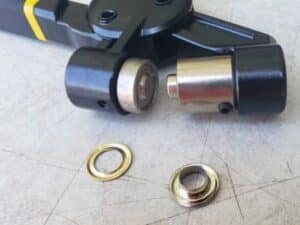Recently I had to put wire mesh on the window to keep my neighbor’s cats from entering our bedroom when the windows are open. I love cats but these had been a menace because they left behind trails of dirty paw prints on everything they stepped. Hence the need to keep them away instead of starting a fight with my good neighbor.
So I set out for the hardware store and bought a few inches of 1/4 hardware cloth and binding wire. That set me up for the project.
Hardware cloth is a type of heavy duty steel mesh. It is made from thicker gauge wire than chicken mesh. Therefore, it is better at keeping cats and small animals away. If you have reared chicken before, you know how easily rodents tear through the chicken mesh. I lost a couple of chickens in the past to raccoons that chewed through the chicken mesh. That is when I learned that chicken wire is only good for keeping birds inside and not for keeping predators out. For that reason, I chose hardware cloth over the chicken wire for my little project.
So, if you are looking for a way to keep varmints from entering your house through the windows or vents, or to protect your chicken from raccoons, or trees from rodents, hardware cloth is a good solution. You can try different sizes. For instance, the 1/2″ metal mesh works well on chicken coops since the aim is to keep out big animals while a 1/4″ screens out all the small animals. Also, instead of using binding wire to fasten overlapping mesh, you can try hog rings. They are easier to install, last longer, and look neater.
This is what it took to complete the small home project.

Tools used
- Hardware cloth
- Diagonal cutters
- Masking tape (optional)
- Heavy duty leather gloves
Steps
1. Wear protective gloves to protect your hands from injuries.
A pair of heavy-duty leather gloves are the best for handling wire mesh. They are hard enough to keep the sharp ends of steel mesh from piercing through.
2. Stretch the hardware cloth
Since woven mesh is mostly rolled during storage, it tends to roll back when you stretch it. So, try to lay it on a flat surface on the side that was rolled in.
3. Measure the steel mesh to length with a tape measure.
Hook the measuring tape on the end of the mesh and stretch it to get the desired length and mark.
4. Mark with masking tape or cut one of the wires
You can put a masking tape across to mark where you want to cut. Alternatively, cut one of the parallel wires and use it as the reference point for cutting all the other running wires.
5. Cut the mesh to length
Cut the mesh to length with diagonal cutters. Make cuts where the vertical and horizontal wires are welded together to avoid leaving sharp edges. The length does not have to be precise. However, this will leave behind sharp tails on one of the cutaways.
6. Cut the tails

Flush cut the sharp ends at the joint with your pair of dykes. Any wire cutter will also work but diagonal cutters are the best because they cut straight and flush.
7. Attach the hardware cloth to the window and secure it with binding wire
If you are installing hardware cloth on the window like me, align it properly from the inside and secure it on the window frames or grill with binding wire. Use regular pliers to grip and twist the binding wire and cut it to length with the diagonal cutters.
But if your window does not have frames running across, you will need screws and washers to secure the metal cloth to the wall. Alternatively, you can use staples or U-nails if your window has wood frames.
Well, that is how I cut hardware cloth to length with pliers for my home improvement projects. Now the cats do not enter the house through the window anymore. If you are wondering how to cut hardware cloth for your project, now you know how the diagonal cutters can be handy when you don’t have tin snips.









